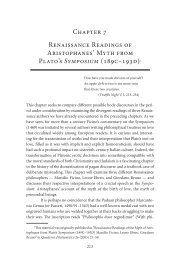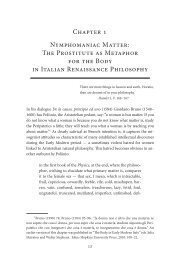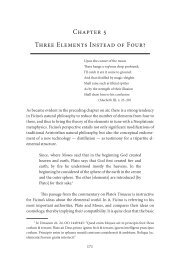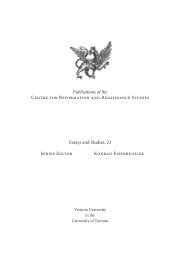Chapter 2 Matter as a Mirror: Marsilio Ficino and Renaissance ...
Chapter 2 Matter as a Mirror: Marsilio Ficino and Renaissance ...
Chapter 2 Matter as a Mirror: Marsilio Ficino and Renaissance ...
Create successful ePaper yourself
Turn your PDF publications into a flip-book with our unique Google optimized e-Paper software.
<strong>Matter</strong> <strong>as</strong> a <strong>Mirror</strong> 57<br />
<strong>and</strong> non-being; the matter in the universe, which is already endowed with<br />
primary forms; <strong>and</strong> already seeded matter, which will bring forth the myriad<br />
forms. 32 In an analogous way, nature organizes matter from within, while man<br />
is capable of shaping matter only from without <strong>and</strong> in imitation of nature’s<br />
art. 33<br />
Yet, <strong>as</strong> we have seen, even according to Plato himself the position<br />
of matter within the hierarchy of being w<strong>as</strong> by no means clear. <strong>Matter</strong> may<br />
either be God’s first creation (this is the position of the Timaeus) or the lowest<br />
element in the hierarchy of being (<strong>as</strong> in the Parmenides <strong>and</strong> in the Sophistes).<br />
As <strong>Ficino</strong> writes: “And this very matter, which in the Parmenides is <strong>as</strong>signed<br />
the lowest rank in the scale of things, is in the Timaeus said to be, <strong>as</strong> it were,<br />
already created <strong>and</strong> subordinated to the architect of the world who realizes<br />
the creation.” 34<br />
This unresolved tension or equivocity of ide<strong>as</strong>, which is intrinsic<br />
to Platonic philosophy in general, indicates that the abstract philosophical<br />
discourse is inextricably bound to a metaphorical substructure. It links the<br />
concept of matter to ide<strong>as</strong> <strong>and</strong> to specifically male anxieties about origin,<br />
procreation, bodies, <strong>and</strong> the female <strong>as</strong>pect in creation. The discourse about<br />
the material world refers to a gendered structure that marks a dialectical relationship<br />
between two universal principles: male (active form) <strong>and</strong> female<br />
(matter/potentiality). Kristeller observes that:<br />
In the degree to which each object is composed of potency <strong>and</strong><br />
act, it is characterised by a p<strong>as</strong>sive element <strong>and</strong> an active element.<br />
In that sense, the relation of act <strong>and</strong> potency is applicable not<br />
only to corporeal changes but to almost all objective relations <strong>as</strong><br />
well, so acquiring a fundamental significance. […] The relation<br />
between matter <strong>and</strong> form appears therefore <strong>as</strong> a particular c<strong>as</strong>e<br />
of that relation, with the result that matter is called “potency,”<br />
form on the other h<strong>and</strong>, “act.” 35<br />
32 On this, see Allen (1989) 14; for a similar distinction of matter in its various stages<br />
of formation see OO 492–493 (De creatione rerum).<br />
33 Theologia IV, 1: I, 146–147; see Allen (1989) 144.<br />
34 In Timaeum chapt. 9, OO 1441: “Hanc utique materiam in Parmenide, ab ipso<br />
bono in ultimo rerum gradu deductam, acipit in Timeo, qu<strong>as</strong>i iam genitam et architecto<br />
mundi, ad effectum mundani operis subditam.”<br />
35 See Kristeller (1943) 40; OO 81, 349, 386–387; Collins (1974) chapts. 1 <strong>and</strong> 4.







